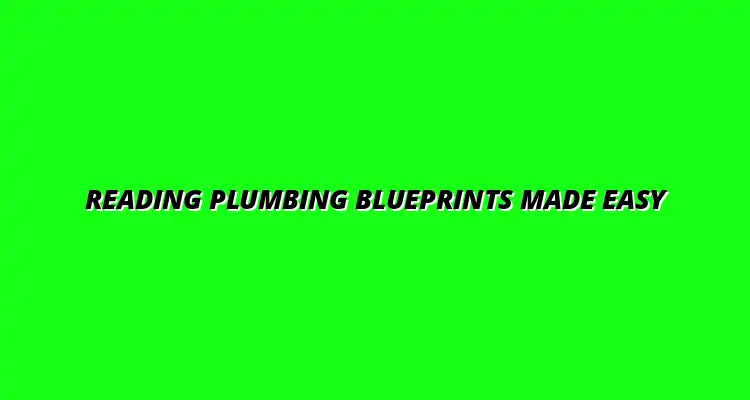
- Beginner Tips
- Feb 19
2024-12-31
If you're new to plumbing, you might find the concept of plumbing blueprints a bit overwhelming. However, these drawings are essential tools that help in planning and executing plumbing projects. They provide a visual representation of how plumbing systems are designed and installed in buildings, making them crucial for both beginners and professionals alike.
Plumbing blueprints are detailed drawings that illustrate the layout and installation of plumbing systems in a building. They show where pipes, fixtures, and appliances are located, as well as how they connect to each other. Understanding these blueprints is key for anyone involved in plumbing work, whether you are a DIY enthusiast or a skilled tradesperson. For a more in-depth understanding of how plumbing systems work, check out this helpful guide: Plumbing Systems Explained for Beginners.
These blueprints typically include both horizontal and vertical layouts, providing a comprehensive view of the plumbing system. They are usually drawn to scale, which means that every symbol and line represents real dimensions in the physical world. This helps in accurately planning plumbing installations and renovations.
Plumbing blueprints play a vital role in ensuring that projects run smoothly. Here are a few reasons why they are important:
By clearly outlining the plumbing system, blueprints help prevent costly mistakes and misunderstandings during the project. This makes them an invaluable resource throughout the entire plumbing process.
One of the first steps in understanding plumbing blueprints is recognizing the symbols used. These symbols represent various plumbing fixtures and components, making it easier to visualize the system. Some common symbols include:
Understanding these symbols is crucial for reading blueprints effectively. As you familiarize yourself with them, you'll become more confident in interpreting plumbing plans.
In addition to symbols, plumbing blueprints feature various lines that indicate the type and size of pipes. Typically, these lines can represent:
Recognizing these lines is essential for understanding how water flows through the system. This knowledge can help you troubleshoot issues or plan new installations. Learning to identify common plumbing problems is a valuable skill; this resource can help: Identifying Common Plumbing Problems.
When reviewing plumbing blueprints, one of the first things to note is the location of fixtures. Fixtures include toilets, sinks, showers, and appliances. They are typically marked with specific symbols, allowing you to see how they fit into the overall plumbing system. For example, knowing how to fix a leaky faucet is a great beginner plumbing skill.
It's also important to pay attention to the spacing between fixtures. Adequate spacing ensures that plumbing systems operate efficiently and that there is enough room for maintenance. Here are some common fixtures you should look for:
By understanding where these fixtures are located, you can better plan your plumbing work and ensure everything is installed correctly.
Another critical aspect of plumbing blueprints is understanding pipe sizes and types. Pipes come in various diameters and materials, which affect water flow and pressure. Blueprints usually include annotations indicating these details.
This is important for ensuring that the correct materials and sizes are used during installation. Here’s what to look for:
Being familiar with these details helps in selecting the right materials for your plumbing projects. If you're tackling a kitchen plumbing project, this guide on repairing a leaky sink might be helpful: Repairing a Leaky Kitchen Sink.
Scale drawings are a fundamental part of plumbing blueprints. They allow you to understand how the plumbing system will fit within the physical space of the building. Typically, a scale will be indicated on the blueprint, showing how many units on the drawing correspond to real-life measurements.
For instance, a common scale might represent 1 inch on the drawing as equal to 10 feet in reality. Understanding this concept is essential to ensure proper installations. When reading blueprints, always check the scale to avoid mistakes!
To measure distances accurately on plumbing plans, you'll need a ruler or scale that matches the drawing's scale. Here’s a simple process to follow:
By practicing this method, you'll improve your ability to visualize the plumbing system's layout and ensure everything fits as planned. For DIY enthusiasts, a beginner's guide to bathroom plumbing can be very valuable: Beginner's DIY Bathroom Plumbing Guide.
Reading plumbing blueprints might seem complex, but breaking it down into simple steps can help. Here's a step-by-step guide:
By following these steps, you'll gain a better understanding of how to interpret basic plumbing plans, making the process much easier!
Even beginners can make mistakes when first trying to read plumbing blueprints. To help you avoid these pitfalls, here are some common errors:
By being aware of these mistakes, you can approach plumbing blueprints with more confidence and accuracy. Proper water heater maintenance is crucial; this guide can help: Water Heater Maintenance Made Simple.
While both plumbing and architectural blueprints are essential in building design, they serve different purposes. Architectural blueprints focus on the overall design and layout of the structure, including walls, doors, and windows. In contrast, plumbing blueprints concentrate specifically on the plumbing systems, detailing how pipes and fixtures are arranged.
Understanding this difference can help you know what to look for when reviewing each type of blueprint.
Practicing reading plumbing blueprints is a great way to build your skills. Here are some suggestions for beginners:
By engaging with real blueprints and practicing regularly, you'll improve your reading skills and boost your confidence! If you need help with a specific plumbing issue in Birmingham, consider contacting a local plumber: Plumber in Billesley, Birmingham.
Understanding how to read plumbing blueprints can vastly improve your ability to tackle plumbing projects. Whether you're a DIY enthusiast or working with professionals, knowing how to utilize these blueprints is crucial. They provide a roadmap for your plumbing layout, ensuring everything fits together seamlessly.
When planning a DIY plumbing project, blueprints serve as a *guideline* for your entire layout. They help you visualize where pipes, fixtures, and connections will go. This clarity can make a significant difference in the overall success of your project.
Following a systematic approach when planning your plumbing layout can save you time and resources. Start by considering the flow of water and drainage. Here’s a simple checklist to help you:
Every locality has specific plumbing codes that must be followed to ensure safety and functionality. Blueprints can help you check if your planned layout meets these regulations. Make sure to:
When working with professional plumbers, having a clear set of blueprints can enhance collaboration. It allows everyone involved to be on the same page about the project's scope and specifics. Clear communication can lead to more effective teamwork and fewer costly mistakes.
Effective communication with your plumber can make your project go smoothly. Use your blueprints as a tool to discuss:
Blueprints not only assist in execution but also serve as a reference for managing the entire project. They help in tracking progress and adjusting plans as needed. Here are some benefits to consider:
If you're eager to enhance your understanding of plumbing blueprints, various resources can help you. Here are some avenues to explore:
Books and online courses can provide valuable insights and practical knowledge. Consider checking out:
Technology can make reading and interpreting blueprints much easier. Here are some useful tools:
As we wrap up, remember that understanding plumbing blueprints is a skill that takes practice. The more you familiarize yourself with the symbols and layouts, the more confident you'll become in your plumbing projects. Don't hesitate to refer back to the basics anytime you feel stuck.
Here’s a quick recap of what we've covered regarding plumbing blueprints:
Finally, don't be afraid to practice and seek out help. Whether it's through friends, online forums, or local plumbers, engaging with others can provide you with new perspectives and solutions. Happy plumbing!
